Accident Severity Analysis of Traffic Accident Hot Spot Areas in Changsha City Considering Built Environment
Abstract
1. Introduction
2. Data Preprocessing
2.1. Traffic Accident Hotspot Identification in Changsha
2.2. Variable Selections
2.3. Data Imbalance Treatment
- SMOTE
- (1)
- For each minority class sample, find its K nearest neighbours.
- (2)
- A number of samples are randomly selected for the K nearest neighbours, and a new sample is generated by randomly selecting a point on the line connecting them to their nearest neighbours.
- (3)
- Repeat until balanced.
- ENN
- (1)
- Calculate the majority class sample proportion of its K nearest neighbours for newly generated samples from SMOTE.
- (2)
- If the sample is a minority class sample and has more than 50% of its nearest neighbours in the majority class, remove it.
- (3)
- Integration to generate new data.
3. Methods
3.1. LightGBM
3.2. SHAP
4. Result and Discussion
4.1. Result
4.2. Discussion
5. Conclusions
- (1)
- In different accident areas within the city, the features influencing accident severity and the built environment factors differ. In HAAs, the primary influencing factors include type of accident, visibility, land use mixing degree, weather, period of time, and population density. Conversely, in LAAs, the key factors revolve around type of accident, period of time, visibility, landform, weather, and intersection density.
- (2)
- The importance of certain factors in influencing the severity of accidents varies between different accident hotspots. However, the overall trend in their impact on accidents remains consistent. With regard to factors related to accident characteristics, vehicle–pedestrian accidents, vehicle–non-motorized vehicle accidents, poor visibility, and midnight driving exacerbate accident severity. Among the factors related to the built environment, an increase in the land use mixing degree, population density, density of commercial places, density of industrial places, density of intersections, density of traffic places, and density of public places correlates positively with a decrease in fatal accidents.
- (3)
- There are significant differences in the trends of the impacts of certain factors on accident severity between different urban accident areas. With regard to the built environment, transportation accessibility and road network density exhibit varying effects on accident severity. Meanwhile, differences in landform and accident location lead to an inconsistent impact on accident severity in terms of accident characteristics.
Author Contributions
Funding
Institutional Review Board Statement
Informed Consent Statement
Data Availability Statement
Conflicts of Interest
References
- Ding, C.; Chen, P.; Jiao, J. Non-linear effects of the built environment on automobile-involved pedestrian crash frequency: A machine learning approach. Accid. Anal. Prev. 2018, 112, 116–126. [Google Scholar] [CrossRef]
- Chen, P.; Sun, F.; Wang, Z.; Gao, X.; Jiao, J.; Tao, Z. Built environment effects on bike crash frequency and risk in Beijing. J. Saf. Res. 2018, 64, 135–143. [Google Scholar] [CrossRef] [PubMed]
- Yoon, J.; Lee, S. Spatio-temporal patterns in pedestrian crashes and their determining factors: Application of a space-time cube analysis model. Accid. Anal. Prev. 2021, 161, 106291. [Google Scholar] [CrossRef] [PubMed]
- Afghari, A.P.; Haque, M.M.; Washington, S. Applying a joint model of crash count and crash severity to identify road segments with high risk of fatal and serious injury crashes. Accid. Anal. Prev. 2020, 144, 105615. [Google Scholar] [CrossRef]
- Ghezelbash, S.; Ghezelbash, R.; Kalantari, M. Developing a spatio-temporal interactions model for car crashes using a novel data-driven AHP-TOPSIS. Appl. Geogr. 2024, 162, 103151. [Google Scholar] [CrossRef]
- Hu, L.; Wu, X.; Huang, J.; Peng, Y.; Liu, W. Investigation of clusters and injuries in pedestrian crashes using GIS in Changsha, China. Saf. Sci. 2020, 127, 104710. [Google Scholar] [CrossRef]
- Lin, N.; Hu, L.; Lin, M.; Peng, H. Black spot identification and analysis of traffic accidents based on time series clustering. J. Chang. Univ. Sci. Technol. Nat. Sci. 2023, 20, 45–54. [Google Scholar]
- Lu, H.; Luo, S.; Li, R. GlS-based Spatial Patterns Analysis of Urban Road Traffic Crashes in Shenzhen. China J. Highw. Transp. 2019, 32, 156–164. [Google Scholar]
- Wang, X.; Zhang, X.; Pei, Y. A systematic approach to macro-level safety assessment and contributing factors analysis considering traffic crashes and violations. Accid. Anal. Prev. 2024, 194, 107323. [Google Scholar] [CrossRef] [PubMed]
- Al Hamami, M.; Matisziw, T.C. Measuring the spatiotemporal evolution of accident hot spots. Accid. Anal. Prev. 2021, 157, 106133. [Google Scholar] [CrossRef] [PubMed]
- Shin, S.; Choo, S. Influence of Built Environment on Micromobility–Pedestrian Accidents. Sustainability 2022, 15, 582. [Google Scholar] [CrossRef]
- Bi, H.; Li, A.; Zhu, H.; Ye, Z. Bicycle safety outside the crosswalks: Investigating cyclists’ risky street-crossing behavior and its relationship with built environment. J. Transp. Geogr. 2023, 108, 103551. [Google Scholar] [CrossRef]
- Lym, Y.; Chen, Z. Influence of built environment on the severity of vehicle crashes caused by distracted driving: A multi-state comparison. Accid. Anal. Prev. 2021, 150, 105920. [Google Scholar] [CrossRef] [PubMed]
- Lee, S.; Yoon, J.; Woo, A. Does elderly safety matter? Associations between built environments and pedestrian crashes in Seoul, Korea. Accid. Anal. Prev. 2020, 144, 105621. [Google Scholar] [CrossRef] [PubMed]
- Wang, J.; Ji, L.; Ma, S.; Sun, X.; Wang, M. Analysis of Factors Influencing the Severity of Vehicle-to-Vehicle Accidents Considering the Built Environment: An Interpretable Machine Learning Model. Sustainability 2023, 15, 12904. [Google Scholar] [CrossRef]
- Yang, C.; Chen, M.; Yuan, Q. The application of XGBoost and SHAP to examining the factors in freight truck-related crashes: An exploratory analysis. Accid. Anal. Prev. 2021, 158, 106153. [Google Scholar] [CrossRef] [PubMed]
- Chen, P.; Shen, Q. Identifying high-risk built environments for severe bicycling injuries. J. Saf. Res. 2019, 68, 1–7. [Google Scholar] [CrossRef]
- Ji, X.; Qiao, X.; Pu, Y.; Lu, M.; Hao, J. Influence mechanism of built environment around subway station on traffic accident risk. China Saf. Sci. J. 2022, 32, 162–170. [Google Scholar]
- Joshi, M.Y.; Rodler, A.; Musy, M.; Guernouti, S.; Cools, M.; Teller, J. Identifying urban morphological archetypes for microclimate studies using a clustering approach. Build. Environ. 2022, 224, 109574. [Google Scholar] [CrossRef]
- Ewing, R.; Cervero, R. Travel and the built environment: A synthesis. Transp. Res. Rec. 2001, 1780, 87–114. [Google Scholar] [CrossRef]
- Clark, J.S.C.; Kulig, P.; Podsiadło, K.; Rydzewska, K.; Arabski, K.; Białecka, M.; Safranow, K.; Ciechanowicz, A. Empirical investigations into Kruskal-Wallis power studies utilizing Bernstein fits, simulations and medical study datasets. Sci. Rep. 2023, 13, 2352. [Google Scholar] [CrossRef] [PubMed]
- Umer, M.; Sadiq, S.; Ishaq, A.; Ullah, S.; Saher, N.; Madni, H.A. Comparison Analysis of Tree Based and Ensembled Regression Algorithms for Traffic Accident Severity Prediction. arXiv 2020, arXiv:2010.14921. [Google Scholar]
- Zeng, J.; Qian, Y.; Yin, F.; Zhu, L.; Xu, D. A multi-value cellular automata model for multi-lane traffic flow under lagrange coordinate. Comput. Math. Organ. Theory 2022, 28, 178–192. [Google Scholar] [CrossRef]
- Glimm, J.; Fenton, R.E. An accident-severity analysis for a uniform-spacing headway policy. IEEE Trans. Veh. Technol. 1980, 29, 96–103. [Google Scholar] [CrossRef]
- Jia, L.; Cheng, P.; Yu, Y.; Chen, S.-H.; Wang, C.-X.; He, L.; Nie, H.-T.; Wang, J.-C.; Zhang, J.-C.; Fan, B.-G.; et al. Regeneration mechanism of a novel high-performance biochar mercury adsorbent directionally modified by multimetal multilayer loading. J. Environ. Manag. 2023, 326, 116790. [Google Scholar] [CrossRef] [PubMed]
- Yan, Y.; Dai, T.; Zhang, Y.; Zhao, S.; Zhang, Y. Neighborhood-aware lmbalanced Oversampling. J. Chin. Comput. Syst. 2021, 42, 1360–1370. [Google Scholar]
- Ke, G.; Meng, Q.; Finley, T.; Wang, T.; Chen, W.; Ma, W.; Ye, Q.; Liu, T.-Y. Lightgbm: A highly efficient gradient boosting decision tree. In Proceedings of the 31st International Conference on Neural Information Processing Systems, Long Beach, CA, USA, 4–9 December 2017; pp. 3149–3157. [Google Scholar]
- Friedman, J.H. Greedy function approximation: A gradient boosting machine. Ann. Stat. 2001, 29, 1189–1232. [Google Scholar] [CrossRef]
- Chen, T.; Guestrin, C. Xgboost: A scalable tree boosting system. In Proceedings of the 22nd ACM Sigkdd International Conference on Knowledge Discovery and Data Mining, San Francisco, CA, USA, 13–17 August 2016; pp. 785–794. [Google Scholar]
- Lundberg, S.M.; Lee, S.I. A unified approach to interpreting model predictions. In Proceedings of the 31st International Conference on Neural Information Processing Systems, Long Beach, CA, USA, 4–9 December 2017; pp. 4768–4777. [Google Scholar]
- Wei, T.; Zhu, T.; Lin, M.; Liu, H. Predicting and factor analysis of rider injury severity in two-wheeled motorcycle and vehicle crash accidents based on an interpretable machine learning framework. Traffic Inj. Prev. 2024, 25, 194–201. [Google Scholar] [CrossRef] [PubMed]
- Jeong, H.; Kim, I.; Han, K.; Kim, J. Comprehensive analysis of traffic accidents in seoul: Major factors and types affecting injury severity. Appl. Sci. 2022, 12, 1790. [Google Scholar] [CrossRef]
- Li, Y.; Fan, W.D. Modelling severity of pedestrian-injury in pedestrian-vehicle crashes with latent class clustering and partial proportional odds model: A case study of North Carolina. Accid. Anal. Prev. 2019, 131, 284–296. [Google Scholar] [CrossRef]
- Qian, Q.; Shi, J. Comparison of injury severity between E-bikes-related and other two-wheelers-related accidents: Based on an accident dataset. Accid. Anal. Prev. 2023, 190, 107189. [Google Scholar] [CrossRef] [PubMed]
- Fatmi, M.R.; Habib, M.A. Modeling vehicle collision injury severity involving distracted driving: Assessing the effects of land use and built environment. Transp. Res. Rec. 2019, 2673, 181–191. [Google Scholar] [CrossRef]
- Zhang, G.; Yau, K.K.W.; Zhang, X.; Li, Y. Traffic accidents involving fatigue driving and their extent of casualties. Accid. Anal. Prev. 2016, 87, 34–42. [Google Scholar] [CrossRef] [PubMed]
- Ewing, R.; Dumbaugh, E. The built environment and traffic safety: A review of empirical evidence. J. Plan. Lit. 2009, 23, 347–367. [Google Scholar] [CrossRef]
- Prato, C.G.; Kaplan, S.; Patrier, A.; Rasmussen, T.K. Considering built environment and spatial correlation in modeling pedestrian injury severity. Traffic Inj. Prev. 2018, 19, 88–93. [Google Scholar] [CrossRef] [PubMed]
- Yasmin, S.; Eluru, N. Latent segmentation based count models: Analysis of bicycle safety in Montreal and Toronto. Accid. Anal. Prev. 2016, 95, 157–171. [Google Scholar] [CrossRef]
- Ji, X.; Qiao, X. Nonlinear Influence of Built Environment on Pedestrian Traffic Accident Severity. J. Transp. Syst. Eng. Inf. Technol. 2023, 23, 314–323. [Google Scholar]
- Hosseinpour, M.; Yahaya, A.S.; Sadullah, A.F. Exploring the effects of roadway characteristics on the frequency and severity of head-on crashes: Case studies from Malaysian Federal Roads. Accid. Anal. Prev. 2014, 62, 209–222. [Google Scholar] [CrossRef] [PubMed]









| Built Environment Factors | Kruskal-Wallis Test Results | |
|---|---|---|
| Test Statistic | p-Value | |
| Population density | 64.464 | 0.0001 |
| Transportation accessibility | 4.193 | 0.0406 |
| Public accessibility | 3.133 | 0.0767 |
| Business accessibility | 0.765 | 0.3819 |
| Density of public places | 41.314 | 0.0001 |
| Intersection density | 6.242 | 0.0125 |
| Density of greenfield places | 0.042 | 0.8386 |
| Density of industrial places | 5.943 | 0.0148 |
| Density of residential places | 0.167 | 0.6828 |
| Density of traffic places | 5.510 | 0.0189 |
| Density of commercial places | 41.204 | 0.0001 |
| Road network density | 25.652 | 0.0001 |
| Land use mixing degree | 12.171 | 0.0005 |
| Variable | Variable Description | Variable Coding | Number of Variables | |
|---|---|---|---|---|
| HAA | LAA | |||
| Built environment factors | ||||
| Population density | Population density in the area (people/) | 1 = 0–1641 | 917 | 2846 |
| 2 = 1642–12064 | 814 | 1215 | ||
| 3 = >12064 | 80 | 292 | ||
| Transportation accessibility | Distance from accident point to traffic places (m) | 1 = 0–678 | 717 | 1647 |
| 2 = 678–1658 | 565 | 1378 | ||
| 3 = 1658–3000 | 356 | 703 | ||
| 4 = >3000 | 173 | 625 | ||
| Density of public places | Density of public places in the area (pcs/) | 1 = 0–22 | 1348 | 3690 |
| 2 = 23–79 | 386 | 560 | ||
| 3 = >79 | 77 | 103 | ||
| Intersection density | Density of intersections in the area (pcs/) | 1 = 0–228 | 1242 | 3164 |
| 2 = 229–722 | 455 | 941 | ||
| 3 = >722 | 114 | 248 | ||
| Density of industrial places | Density of industrial places in the area (pcs/) | 1 = 0–54 | 1595 | 4001 |
| 2 = 55–316 | 178 | 325 | ||
| 3 = >316 | 38 | 27 | ||
| Density of traffic places | Density of traffic places in the area (pcs/) | 1 = 0–4 | 1526 | 3828 |
| 2 = 5–17 | 237 | 468 | ||
| 3 = >17 | 48 | 57 | ||
| Density of commercial places | Density of commercial places in the area (pcs/) | 1 = 0–132 | 1383 | 3777 |
| 2 = 133–496 | 361 | 479 | ||
| 3 = >496 | 67 | 97 | ||
| Road network density | Density of road network in the area (m/) | 1 = 0–5392 | 1019 | 2653 |
| 2 = 5392–12093 | 381 | 1166 | ||
| 3 = >12093 | 411 | 534 | ||
| Land use mixing degree | The degree of mixing of different types of land uses in the area | 1 = 0–0.305 | 317 | 1195 |
| 2 = 0.305–0.914 | 683 | 1216 | ||
| 3 = >0.914 | 811 | 1942 | ||
| Accident characterization factors | ||||
| Type of accident | Type of collision parties | 1 = Vehicle-Pedestrian accidents | 555 | 1326 |
| 2 = Vehicle-Non-motorized Vehicle accidents | 432 | 1014 | ||
| 3 = Vehicle-Vehicle accidents | 824 | 2013 | ||
| Season | Season in which the accident occurred | 1 = spring (3–5) | 543 | 1261 |
| 2 = summers (6–8) | 465 | 1127 | ||
| 3 = fall (9–11) | 427 | 1031 | ||
| 4 = winters (12–2) | 376 | 934 | ||
| Periods of time | Time of accident | 1 = midnight (0–5) | 211 | 469 |
| 2 = morning (6–11) | 518 | 1202 | ||
| 3 = afternoon (12–17) | 565 | 1385 | ||
| 4 = evening (18–24) | 517 | 1297 | ||
| Accident location | Location of the road cross-section of the accident | 1 = motorized road | 1283 | 3093 |
| 2 = non-motorized road | 87 | 155 | ||
| 3 = mixed motorized and non-motorized road | 314 | 757 | ||
| 4 = sidewalk | 40 | 128 | ||
| 5 = other | 87 | 220 | ||
| Traffic controls | Whether there is traffic control on the accident road | 1 = uncontrolled | 571 | 1230 |
| 2 = controlled | 1240 | 3123 | ||
| Road structure | Accident road material | 1 = bitumen | 1442 | 3478 |
| 2 = cement | 338 | 744 | ||
| 3 = other | 31 | 131 | ||
| Type of intersection section | Type of intersection section where the accident occurred | 1 = fork in road | 119 | 213 |
| 2 = crossroad | 309 | 446 | ||
| 3 = section | 1360 | 3606 | ||
| 4 = ramps or roadway entrances and exits | 23 | 88 | ||
| Road alignment | Type of accident road | 1 = straight | 1084 | 3028 |
| 2 = curve road | 666 | 1210 | ||
| 3 = ramp | 56 | 89 | ||
| 4 = Curve and Ramp | 5 | 26 | ||
| Weather | Weather at the time of the accident | 1 = sunny | 1117 | 2657 |
| 2 = cloudy | 305 | 810 | ||
| 3 = rainy | 382 | 854 | ||
| 4 = other | 7 | 32 | ||
| Visibility | Visibility at the time of the accident (m) | 1 = <50 m | 354 | 762 |
| 2 = 50 − 100 m | 665 | 1408 | ||
| 3 = 100 − 200 m | 394 | 1011 | ||
| 4 = >200 m | 398 | 1172 | ||
| Landform | landform of the accident road | 1 = plain | 637 | 1645 |
| 2 = hilly | 1132 | 2599 | ||
| 3 = mountain | 42 | 109 | ||
| Lighting conditions | Light conditions at the time of the accident | 1 = daytime | 1076 | 2642 |
| 2 = street lights at night | 447 | 1122 | ||
| 3 = no street lights at night | 165 | 412 | ||
| 4 = dawn or dusk | 123 | 177 | ||
| Accident severity | Consequences of accidents | 0 = non-fatal | 1372 | 3276 |
| 1 = fatal | 439 | 1077 | ||
Disclaimer/Publisher’s Note: The statements, opinions and data contained in all publications are solely those of the individual author(s) and contributor(s) and not of MDPI and/or the editor(s). MDPI and/or the editor(s) disclaim responsibility for any injury to people or property resulting from any ideas, methods, instructions or products referred to in the content. |
© 2024 by the authors. Licensee MDPI, Basel, Switzerland. This article is an open access article distributed under the terms and conditions of the Creative Commons Attribution (CC BY) license (https://creativecommons.org/licenses/by/4.0/).
Share and Cite
Yan, R.; Hu, L.; Li, J.; Lin, N. Accident Severity Analysis of Traffic Accident Hot Spot Areas in Changsha City Considering Built Environment. Sustainability 2024, 16, 3054. https://doi.org/10.3390/su16073054
Yan R, Hu L, Li J, Lin N. Accident Severity Analysis of Traffic Accident Hot Spot Areas in Changsha City Considering Built Environment. Sustainability. 2024; 16(7):3054. https://doi.org/10.3390/su16073054
Chicago/Turabian StyleYan, Ruizhe, Lin Hu, Juanjuan Li, and Nanting Lin. 2024. "Accident Severity Analysis of Traffic Accident Hot Spot Areas in Changsha City Considering Built Environment" Sustainability 16, no. 7: 3054. https://doi.org/10.3390/su16073054
APA StyleYan, R., Hu, L., Li, J., & Lin, N. (2024). Accident Severity Analysis of Traffic Accident Hot Spot Areas in Changsha City Considering Built Environment. Sustainability, 16(7), 3054. https://doi.org/10.3390/su16073054







